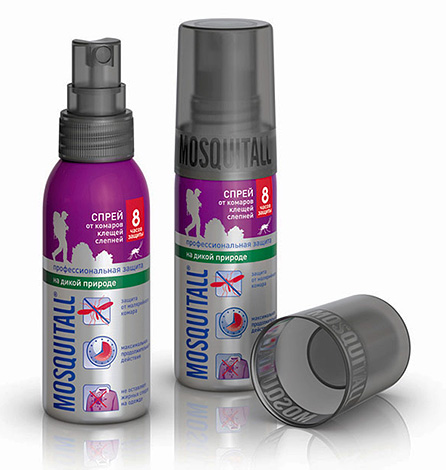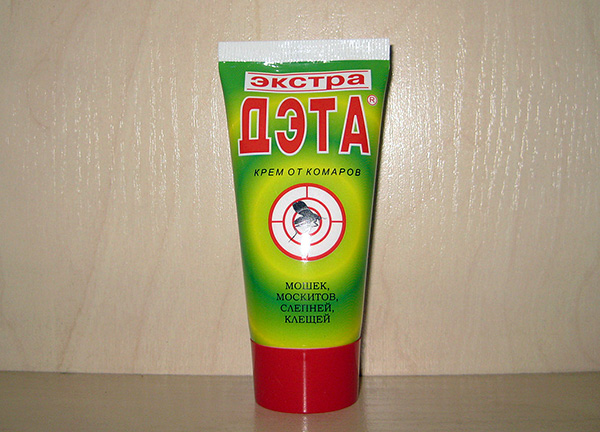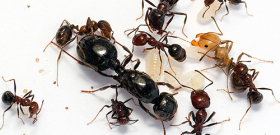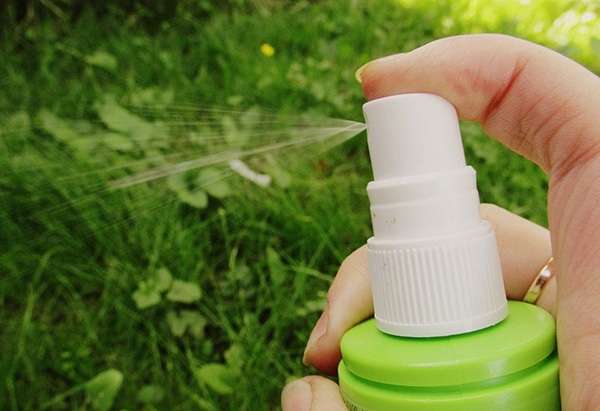
Properly selected tick repellent is one of the important components of reliable protection for people in nature. As a rule, such means are understood as preparations in the form of aerosols and creams intended for application to human skin, clothing and equipment, less often - various textile products (the so-called tick traps), which in one way or another prevent bites.
Interestingly, the chemicals used in such products for the most part effectively protect not only from ticks, but also from other blood-sucking insects - mosquitoes, midges, horseflies, fleas. Often, such parasites pose an even greater threat to a good outdoor recreation than ticks - because of their importunity and abundance.
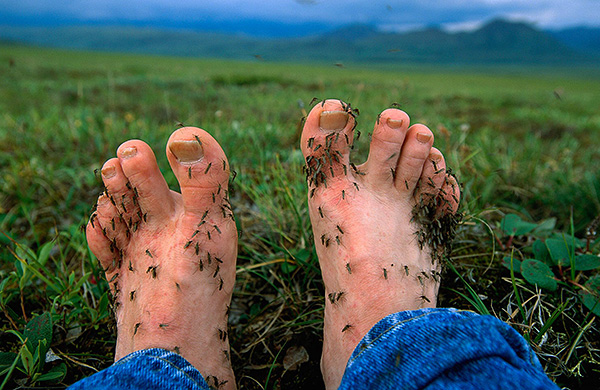
And although full and absolute protection from tick bites chemicals do not provide (this is important to understand), the experience of hunters, fishermen, tourists, travelers and people who often visit nature on duty clearly shows that, in combination with other precautions, they can reduce the likelihood of bites to almost zero. It can be said that with the right equipment of a person in nature, acaricidal and repellent preparations provide 40-50% protection, and the rest is the contribution of other measures.
Of course, this is relevant only with the right choice of means suitable for a particular person and specific conditions of use.So, it is worthwhile to carefully understand their range and selection rules ...
Forms of release of funds from ticks: which option is better?
Among all the remedies for tick bites, chemicals that repel or kill parasites are quite widespread. They are relatively inexpensive, readily available, and easy to use.
All of them can be divided into three types:
- Aerosols in cans or sprays in bottles with a spray mechanism. Of these, the drug is sprayed onto the skin or clothing and remains here for several hours or even days before weathering or washing off;

- Creams or gels to be applied to the body;

- Homemade folk remedies in the form of oils, alcohol tinctures, ointments, decoctions or emulsions. In terms of efficiency, they are significantly inferior to modern "chemistry".
All such tools differ in ease of use in certain cases. For example, an aerosol can be easily and quickly applied to a surface of a relatively large area, but it can be difficult (or simply impossible) to treat, for example, the face, head, since the drug can get into the eyes and respiratory tract. In this case, it is more convenient to use a cream that is applied with fingers only to the desired areas of the skin. At the same time, the cream is very inconvenient to apply on clothes.
As a rule, if the walk is planned in very hot weather, and it will be inconvenient to wear trousers and clothes with long sleeves (that is, large areas of the body will have to be protected from ticks), then it is more convenient to use aerosols.

They also stop the choice when it is expected to stay in areas with a lot of midges and the need to process, including clothes through which mosquitoes and midges can bite a person.
If the main surface of the body is covered by clothing, and protect against ticks you only need hands and feet below the ankle, and additionally also a face from mosquitoes, then it would be more correct to combine aerosol and cream.
On a note
It is useful to consider that when applied directly to the skin, the cream retains its effect somewhat longer than an aerosol or spray.
Practice shows that various folk remedies are much less effective than creams and aerosols. As a rule, when using them, one cannot be sure that they will provide at least some protection even at the places of application. Usually they are used either in addition to fixed assets, or simply as moral support. It is very dangerous to use them as the only means of protection against tick bites during a long stay in places with a large accumulation of these parasites.
Differences in the mechanism of action of funds
Different preparations for ticks contain different active substances in their composition, which can differ significantly in the mechanism of action on arthropods.
All active substances in them can be divided into two main groups:
- Repellents, the main task of which is to repel ticks and prevent them from attaching to skin or clothing;
- Acaricides, on contact with which ticks die.
Most drugs have both a repellent and a poisoning effect on parasites, however, for each substance, one of these actions turns out to be the main, prevailing one.
Of the repellent substances, DETA is the most famous - diethyltoluamide. It does not belong to acaricides or insecticides, but it is very effective in repelling bloodsuckers. If you apply the drug with it on your leg and walk on the grass on which ticks sit, then the parasites will either not cling to the skin at all, or after hooking they will quickly fall to the ground.
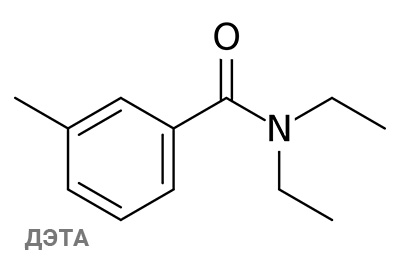
It is interesting
At the dawn of the use of DEET-based drugs, it was believed that this substance disrupts the functions of receptors in insects and mites, with the help of which they smell carbon dioxide and human sweat. Simply put, it was believed that DEET “blinds” ticks and mosquitoes, which, due to the action of the agent, cannot find human skin. Later studies showed that the substance does not have such "disorienting" properties, but it does scare away arthropods by irritating the olfactory receptors.
Other commonly used against ixodid ticks repellents are dimethyl phthalate, carboxide, benzoylpiperidine and some others.
The acaricides used in tick remedies are primarily pyrethroids - permethrin, cypermethrin, alpha-cypermethrin, tetramethrin. Organophosphorus compounds, despite their high toxicity to mites, are not used in preparations applied to the skin and clothing due to an unpleasant odor and relatively high toxicity to humans.
Pyrethroids, in addition to a pronounced toxic effect, also repel ticks. This means that the parasite, most likely, will not cling to a leg or trouser leg, treated, for example, with an agent based on alpha-cypermethrin, and if it clings, then it will fall off without biting.
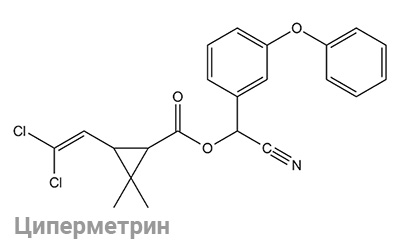
There are no significant differences in effectiveness between repellents or acaricides. That is, by and large, for normal conditions of use, it is not particularly important which agent to buy for protection against ticks - DETA-Prof based on DEET or Gardex Extreme based on a mixture of pyrethroids: both will act approximately equally effectively against parasites.
On a note
There is no relationship between the type of active substance and the formulation of the drug.Both aerosols with lotions and creams are equally often produced with both repellents and acaricides. Moreover, you can buy them not only in pharmacies, but also in hardware stores, since they are not medicines.
Interestingly, folk remedies are mainly designed to repel ticks. Moreover, they do not always cope even with this task. Often, those who use them believe that the stronger the smell of the product, the more it will scare the ticks and the better it will work. As a result, they try to use vinegar, essential oils, kerosene, onions and garlic against parasites, which ticks, in fact, are not afraid of at all. Means that kill ticks directly on the body and clothes are not known among folk recipes.

Nevertheless, some folk remedies remain very popular, have good reviews and are included in many ratings of the "best" acaricides for two reasons:
- Most people, in principle, rarely meet ticks, but when they use such a remedy for protection, they believe that the ticks did not touch them precisely due to the action of the same essential oil or apple cider vinegar;
- Such tools can be easily made at home with your own hands;
- Folk remedies for the most part are not toxic, they are not as afraid as "terrible chemistry".
The last reason is perhaps the most significant. Almost all folk remedies can be smeared indefinitely, without interruption and in large quantities. Even special children's repellents do not provide such an opportunity, since all drugs based on DEET and pyrethroids require strict adherence to safety rules when using them.
Key Tick Repellent Rules You Shouldn't Ignore
Almost all anti-mite products can cause some type of unwanted skin reaction when applied directly to the body or when the body comes into contact with treated clothing. In practice, this happens relatively rarely, and most people do not show any reactions, but this possibility cannot be completely ruled out.
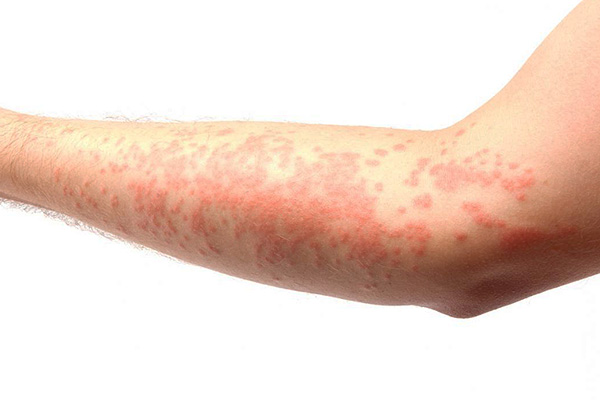
There is also reason to believe that with prolonged continuous use of more than 2-3 weeks, products based on DEET and pyrethroids can lead, albeit to temporary, but noticeable disorders of the nervous system, which are manifested by irritability, nervousness, sleep problems. It is because of this that manufacturers introduce certain restrictions in the instructions for use:
- DEET-based products should not be used continuously for more than 2 weeks. Either the drug should be on the body for 2-3 hours a day, and then washed off, or with continuous treatments (for example, on a camping trip) after 2 weeks, its use must be stopped;
- It is necessary to avoid getting the drug based on pyrethroids in the eyes, nose, mucous membranes of the mouth. Here, the active substances can easily be absorbed into the bloodstream and lead to poisoning;
- For children, products with DEET and pyrethroids can be used continuously for no more than 3 days in a row, and for each drug, depending on the concentration of the active substance in it, there are strict age restrictions. As a general rule, DEET-based products should not be used in children under 3 years of age. Likewise, most of these drugs are prohibited for use by pregnant women;
- If any undesirable consequences appear - allergies, itching - the use of the product must be stopped immediately.
Any agent applied to the body should preferably be washed off as soon as a person enters the room or finds himself where ticks and other parasites do not pose a danger to him. For example, on a hiking trip, it is desirable in the evening, before entering the tent, to swim and wash off the product, and apply a new portion in the morning.

Similarly, after a walk in the park, upon returning home, the drug should also be washed off from yourself and the child.
On the other hand, if during a walk or hike after applying the product to the legs, you had to go into the water, then the drug must be applied to the body again (this is especially true for aerosols - they are washed off very quickly with water). In any case, after contact of the body with water, it is useful to look at the behavior of mosquitoes: if they do not sit on wet areas of the skin, then ticks will not attach to these areas.
See also useful nuances in the article Where ticks usually live in nature: typical habitats.
Means of the Mosquitall line
Mosquitall is widely known as a manufacturer of effective mosquito and midge repellents. There are also insecticidal preparations in the line: two products are produced under this brand - a spray and an aerosol, both with a volume of 100 ml and with different spraying devices.
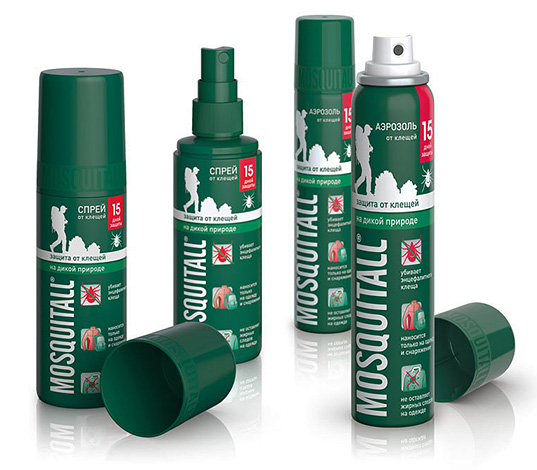
Both products contain alpha-cypermethrin (in the amount of 0.2%) and DEET (in the amount of 7%). Due to DEET, drugs repel ticks and prevent their attack, and if single individuals are on treated clothing or on the skin, they die due to the action of alpha-cypermethrin.
At the same time, the concentration of DEET in these insecticidal-repellent products is relatively low, and therefore the repellent effect lasts only for 2-3 hours.That is, this is a good remedy for protection against ticks on a walk, but more powerful preparations will be required for use on a hunt or on a camping trip.
The price of one bottle of Mosquitall aerosol is about 150 rubles, a spray is about 100 rubles. To protect one person during occasional walks in parks and in the suburbs, one bottle is enough for about a month and a half, depending on the frequency of such walks.
Picnic Tick Remedies
The Picnic line of anti-tick products includes Extreme products based on DEET and Family Strengthened anti-mites with imiprotrin and alpha-cypermethrin.
The DEET content in Picnic Extreme is higher than in Mosquitall, which keeps it repellent longer after application to skin and clothing.

On a note
The manufacturer (by the way, the same one that produces Mosquitol) claims that the protective effect lasts for 12 hours after application, although official DEET tests show that 12 hours of products with it retain the effect only at a concentration of 100% (that is, if it is agent is pure DEET). In Picnic Extreme, the concentration of diethyltoluamide is about 26%, which, according to tests, should ensure the action of the product for 3-4 hours on the body.
It can be assumed that the effect of DEET or pyrethroids in Picnic preparations is enhanced by the perfume composition. In Extreme it is alcohol-based andiroba oil, in Family Reinforced it is eucalyptus oil. However, such oils cannot increase the protection period at times. Therefore, Picnic preparations should be considered as very close analogues of Mosquitall. They cost about the same - about 150 rubles per 100 ml bottle.
Gardex Extreme line
Gardex Extreme can be considered an analogue of Picnic Extreme - this product is also sold as an aerosol in a can and contains DEET (31%) and essential oils of fir and geranium as active ingredients. Given the high concentration of DEET, it can be expected that the surfaces treated with it will repel ticks for 3-5 hours.
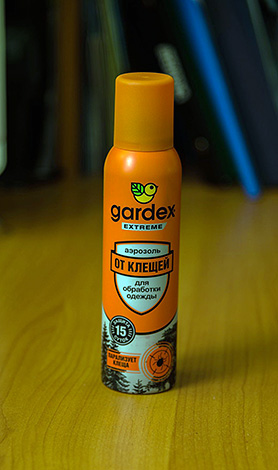
The disadvantage of this tool is that it cannot be used for children. One bottle costs about 200 rubles.
Especially for children in the Gardex line there is a drug Gardex Baby with a small concentration of DEET (8%) and alpha-cypermethrin (0.2%), identical in composition to Mosquitall from ticks. It can only be applied to the child's clothes, where it repels ticks for 2-3 days.
Off extreme remedy
Off Extreme is an analogue of Picnic Extreme and Gardex Extreme. In its composition, the active substance is DEET at a concentration of 30%. After application to the skin, the product remains effective for about 4-5 hours, after application to clothing - several days.
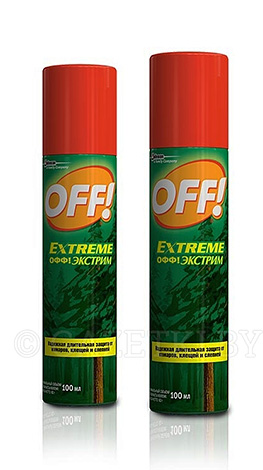
The cost of a 100 ml bottle is about 200 rubles.
Breeze Antiklesh
Breeze Antiklesh is positioned for sale as a professional remedy for tick protection. It is opposed to drugs "for picnics" and the emphasis is on the powerful composition and fullness of the balloon.
So, the manufacturer claims that when "amateur" aerosols are poured into cylinders by 30-40% of the volume, which cannot be verified in any way, then in Briz Antiklesh the filling occupies 70% of the volume (it is impossible to pour more so that there is a gas "cushion" in the cylinder that pushes liquid). That is, buying Briz Antiklesch, the buyer acquires one and a half to two times more funds.
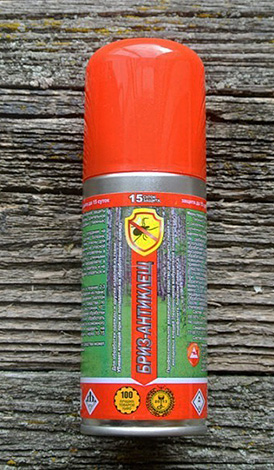
But even if this is so, then this is the only serious advantage of the remedy. Its active ingredient is alpha-cypermethrin at a concentration of 0.25%, which makes it an analogue of Picnic Family Strengthened. At the same time, the price of a 110 ml bottle is approximately 200 rubles. That is, even if we take into account that the data on the fullness of the cylinders are true, the benefit compared to the same Picnic turns out to be insignificant.
On a note
Manufacturer Breeze Antiklesch produces one of the most famous preparations based on DEET among the harsh taiga fishermen - DETA-Prof. The concentration of DEET in it is 30%, the cost of a 110 ml bottle is 200 rubles. A similar remedy is Reftamid from Sibiar at a price of about 200 rubles per 150 ml bottle.
Killing Force Antiklesch
Lethal Force is a drug from the same manufacturer Arnest, which produces the products of the Picnic and Mosquitall lines. Specifically, the Antiklesh aerosol contains 0.2% alpha-cypermethrin and 5% DEET, which makes it an analogue of "light" acaricide-repellant preparations such as Picnic Family. It has no obvious advantages over other means, except that the price of a 150 ml bottle is approximately 150 rubles - less than the cost of similar products.
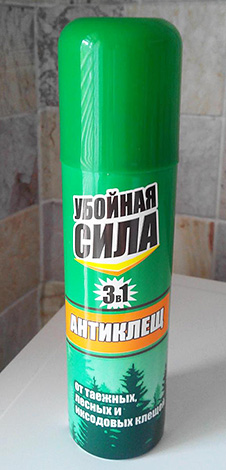
It is interesting
Arnest is also a manufacturer of Dichlorvos brand products and produces Dichlorvos Neo and Dichlorvos Eco. True, only the name remains of the good old Soviet Dichlorvos in these preparations: the active ingredients in them are pyrethroids from the same list that are used in acaricidal preparations. However, Dichlorvos cannot be used to protect the body and clothes from ticks: the active ingredients in it are contained in high concentrations and can lead to poisoning.
Komaroff Antiklesch
Komaroff Antiklesch is another Russian product that does not particularly stand out against the background of analogues. The composition is similar to that of Picnic Family Reinforced: 0.2% alpha-cypermethrin, mint as a fragrance, although, in general, the fragrance of the product cannot be called very pleasant. Unless the price for a bottle of 125 ml is about 100 rubles - this is less than most similar products.

Its only competitor in terms of price is Taiga at the same price, but with an alpha-cypermethrin content of 0.17% (although there are not so many ways to buy it at retail). A smaller amount of the active substance is already contained in preparations for treating areas from ticks. An example of such a remedy is Dr. Klaus from ticks with an alpha-cypermethrin content of 0.12%.
Are ultrasonic tick repellers effective?
Finally, it is impossible not to mention a whole category of dubious electronic devices that allegedly repel ticks with one or another signal and, being switched on on a belt or in a pocket, do not allow parasites to climb onto the leg and stick. These include devices Tickless, Bradex, Antiklesh M and some others.
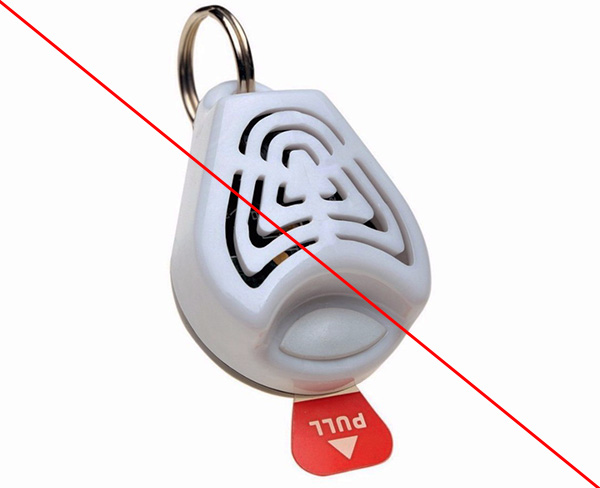
Sellers assure them that the device emits ultrasound that is not audible to humans, but irritates the hairs in the Haller's organ in ticks and leads to their disorientation.
From a scientific point of view, such justifications look very implausible, since it is known that Haller's organ serves as a chemoreceptor for the tick and reacts specifically to odors. Ultrasound is unlikely to affect this organ, and the behavior of the tick itself. In addition, repellers look very similar to devices that are sold to protect against mosquito bites and which, as practice shows, are extremely ineffective.

Be that as it may, it would be extremely imprudent to rely on such repellers and use them only for protection against parasites. Moreover, the results of tests of these devices, carried out by fishermen and hunters, testify to their complete uselessness (see video on YouTube).
Do folk remedies work
The attentive reader must have noticed that essential oils are included in most commercial tick repellents. Here they are used as a perfume to improve the smell of the drug.

The same essential oils are often tried to be used on their own to scare away forest mites and protection from their bites. This approach is ineffective: the smell of any essential oil cannot completely mask the smell of the body and hide it from the ticks that lie in wait for a person. And when the parasite is already hooked on the body or clothing, such oil will definitely not be able to scare it away.
At a minimum, there is no reason to believe that mites are afraid of the smell of any essential oils. And given that parasites attack people who use a large amount of perfumery as actively as people without such means, it can be expected that essential oils will not provide full protection against tick bites.
Approximately the same can be said about other well-known folk remedies, which, as planned, should repel ticks with the smell: vanilla, vinegar, birch tar.
On a note
From folk remedies, a decoction and dry powder from the inflorescences of plants of the pyrethrum genus (for example, Dalmatian chamomile) have acaricidal properties - they contain pyrethrins, natural precursors of pyrethroids. However, the strength of the toxic effect of these substances is much lower than that of synthetic pyrethroids.
So what do you prefer in a particular situation?
To summarize the entire review, we can conclude that it is impossible to find the most effective and universal remedy for ticks for any occasion. Those drugs that will help a hunter or fisherman are too dangerous for a child, and those that can be used for children from 1 year old on walks in the park or at a picnic in Moscow will be ineffective for a tourist walking along the route in Altai for 2-3 weeks.

In addition, you should not rely on chemical agents alone. Even the most effective of them do not provide complete protection: the tick can stick when the repellant wears off, and they don’t have time to reapply the drug, or the aerosol can be rubbed off by grass or washed off afterwards. Therefore, the main area of application of such funds is an addition to protective suits, as well as competent measures for the prevention of tick bites in nature.
For example, to protect a child on a picnic or a walk in the city, it is enough to put on light pants and tuck them into socks, and put on a shirt or jacket with rubber cuffs on the sleeves above the waist. If you fill it in your pants, then no matter what part of the child’s body the tick grabs, it will have to crawl for a long time to the very neck. After that, it is enough to treat the clothes with the agent to be sure that the tick does not get on the body and does not bite.
In many cases, this option is also suitable for adults. You can go fishing or hunting in the taiga in special anti-tick suits, which, when treated with the agent, largely guarantee protection against bites. And only if the day is too hot, and it is impossible to feel comfortable in a suit, you can apply the product to the skin, and then periodically examine the legs.If a parasite is found on the skin, it should be shaken off immediately.

On a note
Practice shows that it is not necessary at all to use some kind of anti-tick means for newborns. Firstly, a newborn child does not crawl in the grass and does not actively collect ticks on itself. And the mother is unlikely to roll a stroller with him through dense thickets in which ticks sit. To be completely sure, you can take any product and spray it on the underside of the stroller to ensure that parasites do not climb up to the edges and on the child himself.
Finally, the main thing: which tool to choose? It must be remembered that all preparations that contain either repellents or acaricides help. The duration of the protective action depends on the concentration of active substances. Therefore, for a trip to heavily infested places, an adult should choose products with a high concentration of DEET - from 20% and above. For use in the city, on short walks, any means containing either DEET, or alpha-cypermethrin, or any other pyrethroid is sufficient.
At the same time, you should always remember that you need to protect yourself first of all not from ticks, but from the infections that they carry. And therefore, in a region dangerous for tick-borne encephalitis, before leaving for the forest thickets, it is necessary to do in advance anti-encephalitis vaccinationso that then any remedy was not the only protection, but simply a certain safety net.
If you have personal experience with the use of certain tick remedies, be sure to share the information by leaving your review at the bottom of this page.
Interesting video: testing various means of protection against ticks

